LOCAL AUTONOMY
Also visit ancient House of Charitable Billionaire Sung Kyu-Ho
Envoys attend Tripitaka Koreana
Festival and see the Upo Wetland
Ambassador Edmundo Sussumu Fujita of Brazil and some 40 other ambassadors and other senior diplomats visited the Haein-sa Buddhist Temple on Sept. 26-27, 2013 at the invitation of Governor Hong Jun-pyo of the South Gyeongsang Province and Mayor Ha Chang-hwan of the Hapcheon County to attend the opening ceremony of the 2013 Tripitaka Koreana Festival at the Haein-sa Temple and its perimeters in Hapcheon County of the Province some 221 miles southeast of Seoul.
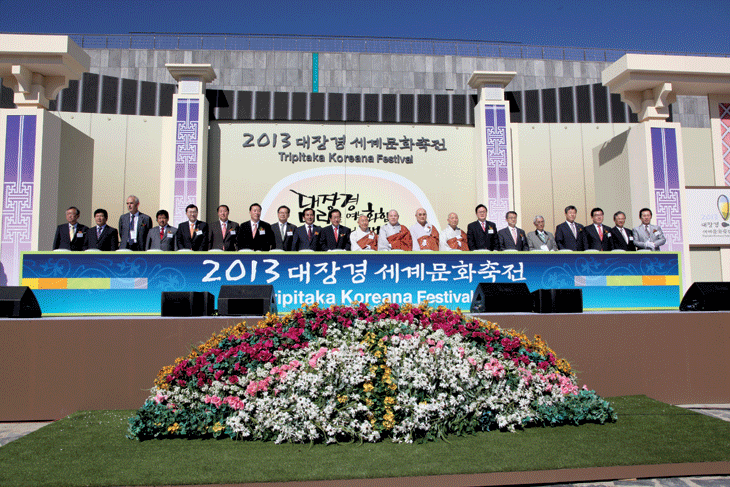
Following their attendance of the Festival, they trod the scenic Sorigil Path, toured the famous Upo Wetland and visited the ancient House of Charitable Billionaire Sung Kyu-Ho, ancestor of Chairman Sung Ki-hak of the Youngone Business Group.

Held on the theme of “Harmony that Opens the Future and Meeting that Leads to the World Peace,” the Festival took place in memory of the safe evacuation of the 80,000 printing wood blocks of the Korean Buddhist Scripture, Tripitaka Koreana, all the way from Ganghwa Island off the West Coast to the Haein-sa Buddhist Temple to escape destruction and damage from war waged by the Northeastern countries.
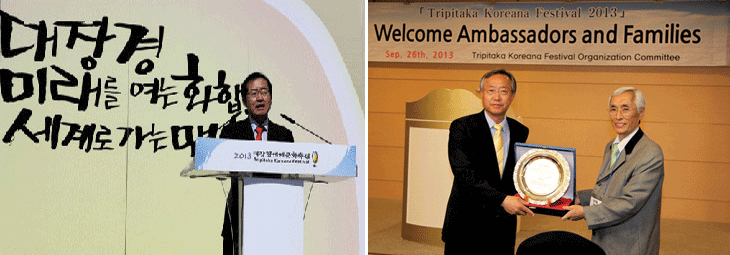
It was a 1-night-2-day tour and involved a long bus ride from Seoul to Hapcheon County, which took about four hours. It was a rather long, boring ride but the ambassadors and other senior diplomats seemed not much bothered obviously from their expectations to learn the Korean culture, especially the rare event show-casing the long evacuation of the Tripitaka Koreana all the way from Ganghwa Island to the Haein-sa Buddhist temple, women carrying them on their head wearing black Chima skirts and white Jeogori coat and men carrying them with a suspending strip of cloth and also on ox carts.

The opening ceremony began with various performances, including songs by a children’s choir formed with little boys and girls of various countries.
Presently, there started a procession of women in black skirts and white coat each carrying a printing wood block of Tripitaka Koreana on their head led by sutra-chanting monks and followed by men carrying the printing wood blocks tied to their front with a strip of cloth.
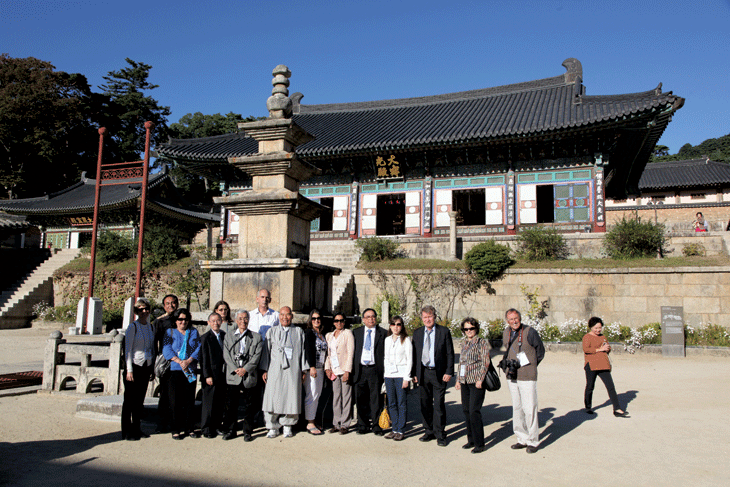
The 2013 Tripitaka Koreana World Culture Festival was opened with the line of Korean and international dignitaries on the stage, including ambassadors, pressing a button signaling the opening of the Festival.
The ambassadors and other dignitaries then were invited to see the genuine printing wood blocks of the Tripitaka Koreana together with replicas on display at the exhibition hall behind the stage of the opening ceremony.

The visiting ambassadors and diplomats then were invited to a large dome-like hall where the guests were shown a ‘five dimensional’ video of the history of the Tripitaka Korean. The guests were provided with a 5D glasses to wear and view the video which showed how the printing blocks were made, when the Korean Buddhist scriptures were printed and how they were evacuated to escape damage during the foreign invasion of Korea.
The 5D video made the guests feel like as if they were actually in the scene of the past as it actually caused various things, including a blast of wind.
The ambassadors and other diplomats then were invited to tour various temple buildings at the Haein-sa Temple on the Gayasan Mountain.
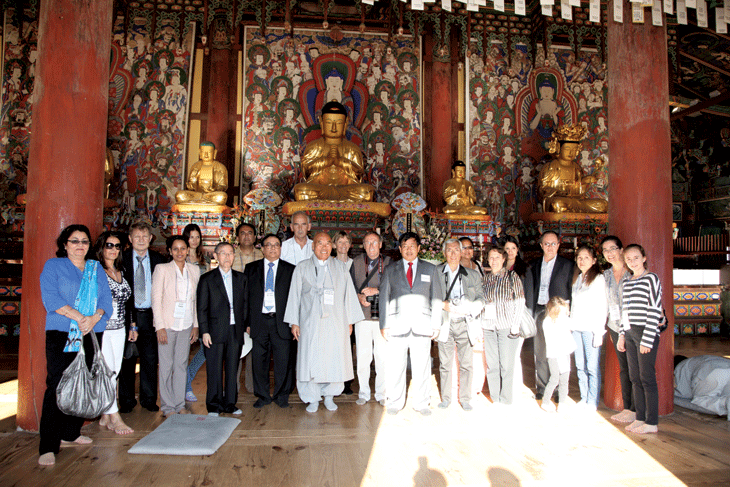
Haein-sa, Temple of the Ocean Mudra, is a head temple of the Jogye Order of Korean Buddhism and is most notable for being the home of the Tripitaka Koreana, the whole of the Buddhist Scriptures carved onto 81,350 wooden printing blocks, which it has housed since 1398.
Haein-sa is one of the Three Jewel Temples of Korea, and represents Dharma or the Buddha’s teachings. It is still an active Seon (Zen) practice center in modern times, and was the home temple of the influential Rev. Seongcheol who died in 1993.
The temple was first built in 802. Legend says that two Korean monks returned from China, Suneung and Ijeong, and healed King Aejang's wife of her illness. In gratitude of the Buddha's mercy, the king ordered the construction of the temple. Another account, by Choe Chi-Won in 900, states that Suneung and his disciple Ijeong, gained the support of a queen dowager who converted to Buddhism and then helped to finance the construction of the temple.
The temple complex was renovated in the 10th century, 1488, 1622, and 1644. Huirang, the temple abbot enjoyed the patronage of Taejo of Goryeo during that king’s reign. Haein-sa was burned down in a fire in 1817 and was rebuilt in 1818. Another renovation in 1964 uncovered a royal robe of King Gwanghaegun, who was responsible for the 1622 renovation, and an inscription on a ridge beam.
The main hall, Daejeokkwang- jeon (Hall of Great Silence and Light), is unusual because it is dedicated to Vairocana where most other Korean temples house Shakyamuni (Kr. Seokgamoni) in their main halls.

The Temple of Haein-sa and the Depositories for the "Tripitaka Koreana" Woodblocks, were added to the UNESCO World Heritage List in 1995. The UNESCO committee noted that the buildings housing the Tripitaka Koreana are unique because no other historical structure was specifically dedicated to the preservation of artifacts and the techniques used were particularly ingenious.
The temple also holds several official treasures including a realistic wooden carving of a monk and interesting Buddhist paintings, stone pagodas, and lanterns.
The temple buildings were erected on the terraced grounds of the mountain slope and naturally there were several stone steps connecting the different levels of the ground. Most of the stone steps were very steep but none of them had any hand rail to protect the visitors from falling down from the steps.
Venerable Park Sung-uk, chief abbot of the Cheonman-sa Buddhist Temple in Ulsan (concurrently editorial writer of The Korea Post on religious affairs), offered prayers to the Buddha at the main temple for the peace and prosperity of Korea and good health of the ambassadors and other senior diplomats visiting the temple that day.

The next destination was the famous Sorigil Path, where Sori meant ‘sound’ and gil the ‘path.’ The name derived from the fact that the treaders of the path heard the sound of the trickling water in the brooks, the chirping of the birds and the rustling of the leaves and twigs caused by the breezes--plus “the sound of the passing time.” (Can anyone hear the sound of the time that elapses?) Whoever has missed the Daejanggyeong tour, really missed something. The brooks and little ponds in places with rocky cliffs standing behind them with varying formations presented a breathtaking view of utter beauty. Many of the visiting ambassadors and senior diplomats, especially their spouses, were completely struck by the landscapes that could be seen only in the fairly land.
The tour was followed by a dinner hosted by the organizers of the Festival, where Ambassador Fujita, dean of the visiting members of the Diplomatic Corp., presented a Plaque of Appreciation to Chairman Kim Yi-soo on behalf of all the visiting members of the Diplomatic Corps. This was followed by an exchange of welcome and congratulatory speeches by Ambassador Fujita of Brazil and Chairman Kim. (See excerpts from the speeches at the end of this Article.)
Then the visiting ambassadors and senior diplomats had a tour of the well-known Upo Wetland of the nearby Changnyeong County. Formed 140 million years ago, the Upo Wetland is the oldest swamp in Korea. The swamp land extends over 700,000 pyeong (2.31 million square meters) that stays natural by the related laws. On March 2, 1998, it was registered and designated as Ramsar swamp. Officially, there are 622 types of animals and plants in the area, forming the paradise of the plants and animals.
The area was selected as an official site to visit during the hosting of the 10th Meeting of the Conference of the Contracting Parties to the Convention on Wetlands, the so-called ‘World Environment Olympics’ on Oct. 28-Nov. 4, 2008.
Like the Siwa Lake on the West Coast, there have been attempts by some of the governments, including Japanese Government General in Korea (1910-1945), to reclaim the land for agricultural and industrial use and in fact a part of the wetland was turned into rice paddies during the Japanese rule of Korea. However, public opinion in support of preservation of the wetland overrode the agricultural and industrial development of the region and finally the region was proclaimed to be preserved as natural swamp land.
Standing out from the flora, is the Euryale Ferox Salisbery, a kind of lotus leaf but much larger in size and equipped with thorns. From this, Koreans call the plant ‘Thorny Lotus Leaf.’
The final destination was the Houses of Charitable Korean Billionaire Sung Kyu-Ho. Billionaire Sung, ancestor of Chairman Sung Ki-Hak of Youngone Business Corporation. Billionaire Sung was well-known benefactor for the poor farmers and very much respected by the common people of the region. At one time, Sung had to tell a lie to the needy people because they would no longer take the rice he gave them because Sung had already given them so much. Sung told them, “This rice is not from me but from the government.” The people took the rice but later found out that it was from Sung. From that time on, the people became more grateful to Sung.
There is an interesting episode related with the cultivation of onion in Korea. In 1908, onion was first planted and cultivated in Korea by Sung Chan-yeong. His grandson, Sung Jae-kyung, encouraged the farmers to plant onion and thus the size of onion farms ultimately increased to over 1,000 hectares in the region. This made Changnyeong County the largest producer of onion in Korea.
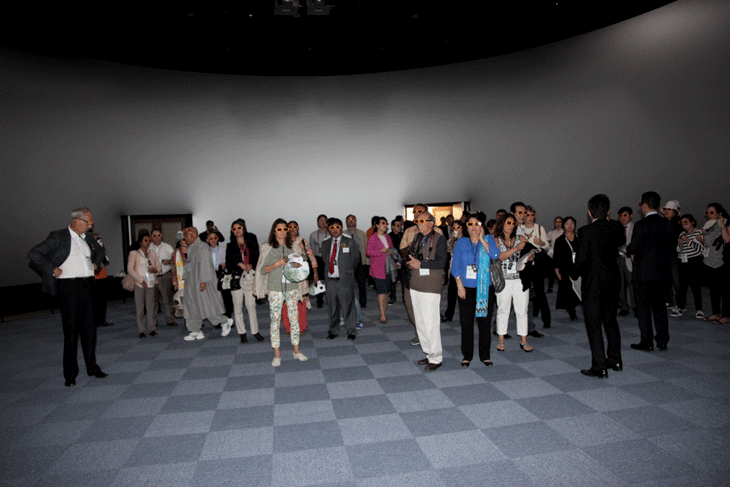
Excerpts from the remarks by Chairman Kim Yi-soo:
Good afternoon and welcome to the Tripitaka Koreana Culture Festival.
I am Yi-Soo Kim, chairman of The Tripitaka Koreana Festival, Organizing Committee.
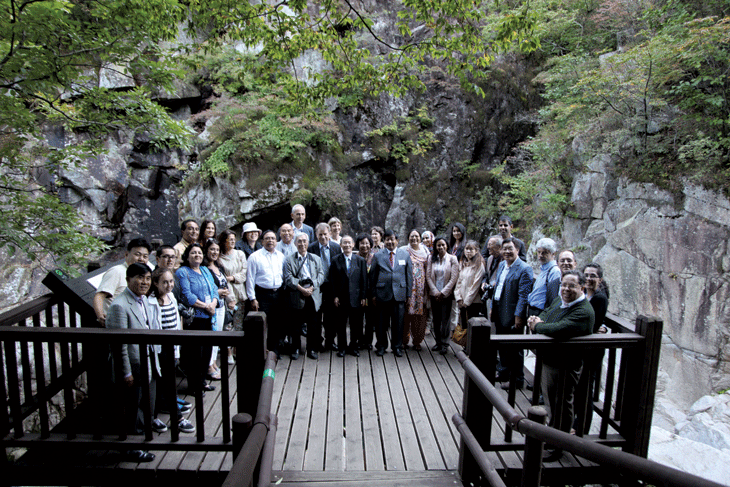
It is my great honor to welcome Your Excellencies and other distinguished members of the Seoul Diplomatic Corps, and I would like to express my profound gratitude for your kind attendance at 2013 Tripitaka Koreana Culture Festival--taking time out of your busy schedule.
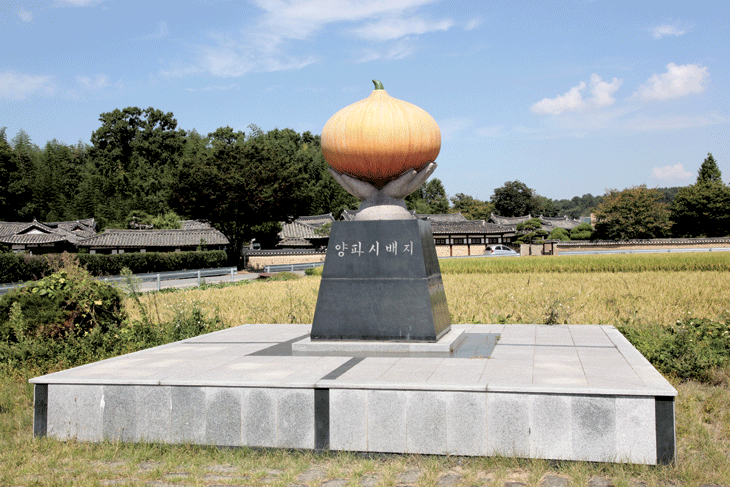
As I mentioned at the Opening Ceremony, Changnyeong City is my home town and the fact that I welcome you here has a special meaning to me.
The Tripitaka Koreana, the main motive of the festival, is not only National Treasure Number 32 but was selected as UNESCO world heritage. It is the essence of the culture of documentation that is 1,000 years old.
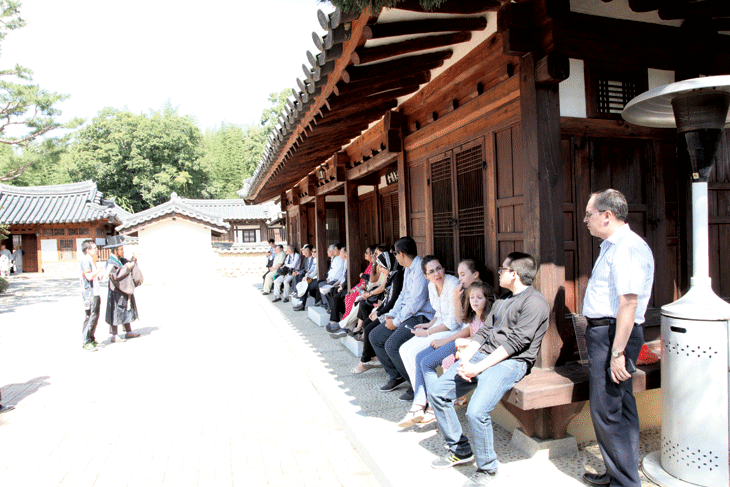
Excerpts from the speech of Ambassador Fujita of Brazil:
On behalf of my colleagues from the Diplomatic Corps, I would like to express our gratitude for your most kind invitation to come to the opening of the 2013 Tripitaka Koreana Culture Festival. It is indeed a unique opportunity to view the fabulous collection of 81,258 wooden printing blocks containing 52,382,960 words that were patiently and painstakingly inscribed in wood by the Goryeo people during 16 years in the 13th century without a single mistake detected.
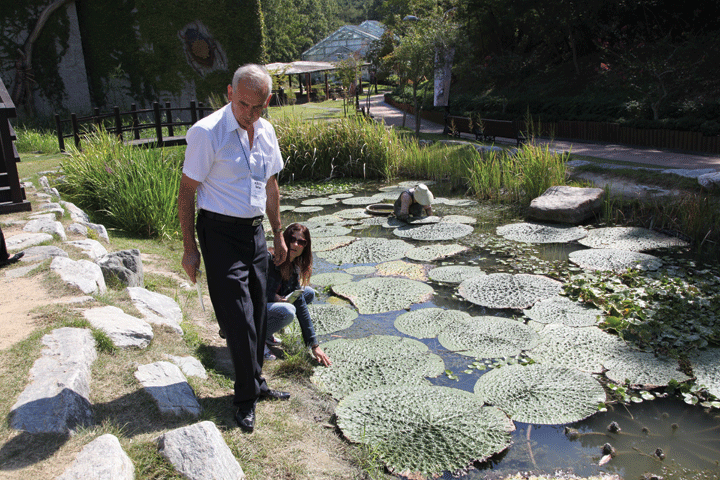
It was also a memorable cultural experience to visit the venerable Haein-sa Temple and its beautiful surroundings which evoke an ambience of sacredness and history that pervades the visitors. I personally had the opportunity of experiencing a temple stay at Haein-sa some years ago and the memories of that visit made me want to come here again.

In 2011 we had the 1.000th anniversary of the completion of this work of art and culture and there was a huge commemoration with national diffusion. I wish that this 13th Festival will keep up the high importance and meaning of the Tripitaka not only to the Korean people but also to whole mankind as a symbol of peace, harmony and fraternity among peoples anywhere and anytime. Once again, thank you for your invitation and hospitality. k


